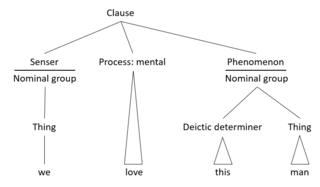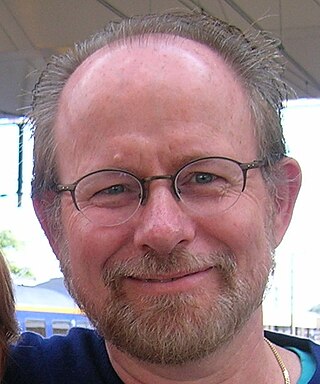Related Research Articles

Functional linguistics is an approach to the study of language characterized by taking systematically into account the speaker's and the hearer's side, and the communicative needs of the speaker and of the given language community. Linguistic functionalism spawned in the 1920s to 1930s from Ferdinand de Saussure's systematic structuralist approach to language (1916).
The phonological hierarchy describes a series of increasingly smaller regions of a phonological utterance, each nested within the next highest region. Different research traditions make use of slightly different hierarchies. For instance, there is one hierarchy which is primarily used in theoretical phonology, while a similar hierarchy is used in discourse analysis. Both are described in the sections below.
Heinz Joachim Giegerich is a Scottish linguist of German nationality, and Emeritus Professor of English Linguistics in the School of Philosophy, Psychology and Language Science of the University of Edinburgh, Scotland.
Arnold Melchior Zwicky is an adjunct professor of linguistics at Stanford University and Distinguished University Professor Emeritus of linguistics at the Ohio State University. The Linguistic Society of America’s Arnold Zwicky Award, given for the first time in 2021, is intended to recognize the contributions of LGBTQ+ scholars in linguistics and is named for Zwicky, the first LGBTQ+ President of the LSA.
Government Phonology (GP) is a theoretical framework of linguistics, and more specifically of phonology. The framework aims to provide a non-arbitrary account for phonological phenomena by replacing the rule component of SPE-type phonology with well-formedness constraints on representations. Thus, it is a non-derivational representation-based framework, and as such, the current representative of Autosegmental Phonology. GP subscribes to the claim that Universal Grammar is composed of a restricted set of universal principles and parameters. As in Noam Chomsky’s principles and parameters approach to syntax, the differences in phonological systems across languages are captured through different combinations of parameter settings.
Angelika Kratzer is a professor emerita of linguistics in the Department of Linguistics at the University of Massachusetts Amherst.
The phonological word or prosodic word is a constituent in the phonological hierarchy. It is higher than the syllable and the foot but lower than intonational phrase and the phonological phrase. It is largely held to be a prosodic domain in which phonological features within the same lexeme may spread from one morph to another, from one clitic to a clitic host, or from one clitic host to a clitic.
Metrical phonology is a theory of stress or linguistic prominence. The innovative feature of this theory is that the prominence of a unit is defined relative to other units in the same phrase. For example, in the most common pronunciation of the phrase "doctors use penicillin", the syllable '-ci-' is the strongest or most stressed syllable in the phrase, but the syllable 'doc-' is more stressed than the syllable '-tors'. Previously, generative phonologists and the American Structuralists represented prosodic prominence as a feature that applied to individual phonemes (segments) or syllables. This feature could take on multiple values to indicate various levels of stress. Stress was assigned using the cyclic reapplication of rules to words and phrases.
Junko Itō is a Japanese-born American linguist. She is emerita research professor of linguistics at the University of California, Santa Cruz.
In linguistics, optimality theory is a linguistic model proposing that the observed forms of language arise from the optimal satisfaction of conflicting constraints. OT differs from other approaches to phonological analysis, which typically use rules rather than constraints. However, phonological models of representation, such as autosegmental phonology, prosodic phonology, and linear phonology (SPE), are equally compatible with rule-based and constraint-based models. OT views grammars as systems that provide mappings from inputs to outputs; typically, the inputs are conceived of as underlying representations, and the outputs as their surface realizations. It is an approach within the larger framework of generative grammar.
Elisabeth O. Selkirk is a theoretical linguist specializing in phonological theory and the syntax-phonology interface. She is currently a professor emerita in the Department of Linguistics at the University of Massachusetts, Amherst.

Jason Kandybowicz is an American linguist, since 2022 Full Professor of Linguistics at The CUNY Graduate Center. He received his Ph.D. from University of California, Los Angeles in 2006 as an advisee of Hilda Koopman. Kandybowicz has researched several endangered and understudied West African languages, including Nupe, Krachi, Ikpana and Asante Twi. Working within the generative grammar framework, he has written several important books and scientific journal articles about Niger-Congo languages and the syntax-phonology interface. He has made a number of media appearances, including interviews for podcasts and the British Broadcasting Company

Harry van der Hulst is full professor of linguistics and director of undergraduate studies at the department of linguistics of the University of Connecticut. He has been editor-in-chief of the international SSCI peer-reviewed linguistics journal The Linguistic Review since 1990 and he is co-editor of the series ‘Studies in generative grammar’. He is a Life Fellow of the Netherlands Institute for Advanced Study, and a board member of the European linguistics organization GLOW.
Maria Luisa Zubizarreta is professor emerita of linguistics at the University of Southern California.
Roumyana Slabakova is a linguist specializing in the theory of second language acquisition (SLA), particularly acquisition of semantics, and its practical implications for teaching and studying languages.
Marina Nespor is a Professor of linguistics at the Scuola Internazionale Superiore di Studi Avanzati in Trieste, Italy, and senior researcher in the ERC PASCAL Project, a project investigating language acquisition and the nature of the biological endowment that allows humans to learn language. Much of Dr. Nespor's research focuses on the interaction of phonology and syntax: what the prosodic structure of an utterance communicates about its grammatical structure.
Michael K. Brame was an American linguist known for his contributions to the field. He served as a professor at the University of Washington and was the founding editor of the peer-reviewed research journal, Linguistic Analysis. Brame's work focused on the development of recursive categorical syntax, also referred to as algebraic syntax, which integrated principles from algebra and category theory to analyze sentence structure and linguistic relationships. His framework challenged conventional transformational grammar by advocating for a lexicon-centered approach and emphasizing the connections between words and phrases. Additionally, Brame collaborated with his wife on research investigating the identity of the author behind the name "William Shakespeare", resulting in several publications. His legacy is marked by his impactful contributions to linguistic theory and his exploration of language intricacies.
Laura J. Downing is an American linguist, specializing in the phonology of African languages.
Henk van Riemsdijk is a Dutch linguist and professor emeritus at Tilburg University.
Alfred (“Al”) D. Mtenje is a professor of Linguistics at the University of Malawi. He is known for his work on the prosody of Malawian Bantu languages, as well as for his work in support of language policies promoting the native languages of Malawi.
References
- ↑ "University of Delaware Linguistics faculty". www.lingcogsci.udel.edu. Retrieved 2021-11-08.
- ↑ "Ph.D. Alumni | Linguistics". linguistics.stanford.edu. Retrieved 2021-11-05.
- ↑ Bakovic, Eric (21 December 2007). "Nespor & Vogel, 1986/2007 | phonoloblog" . Retrieved 2021-11-06.
- ↑ "Prosodic phonology - Google Scholar citations". scholar.google.com. Retrieved 2021-12-04.
- ↑ Booij, Geert (1988). "Review Article" . Journal of Linguistics. 24 (2): 515–525. doi:10.1017/S0022226700011907. ISSN 0022-2267. S2CID 214738539.
- ↑ "Irene Vogel - Google Scholar Citations". scholar.google.com. Retrieved 2021-12-04.